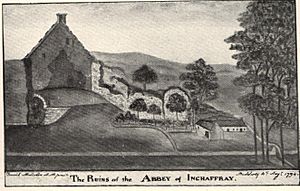Jonathan of Dunblane facts for kids
Quick facts for kids Jonathan |
|
|---|---|
| Bishop of Dunblane | |
| Church | Roman Catholic Church |
| See | Diocese of Dunblane |
| In Office | 1195 × 1198–1210 |
| Predecessor | Simon |
| Successor | Abraham |
| Orders | |
| Consecration | unknown |
| Personal details | |
| Born | unknown unknown |
| Died | 1210 |
| Previous post | Archdeacon of Dunblane (1171 × 1191–1198) |
Jonathan (who died around 1210) was an important church leader in the late 1100s and early 1200s. He lived and worked in a part of Scotland called Strathearn. Jonathan was the Bishop of Dunblane, which meant he was a high-ranking church official in charge of the Diocese of Dunblane (a church district). During his time as bishop, a powerful local ruler named Gille Brigte helped start a new Augustinian priory (a type of monastery) at a place called Inchaffray.
Becoming Bishop of Dunblane
Before becoming a bishop, Jonathan was an Archdeacon of Dunblane. An archdeacon is a church official who helps the bishop manage the diocese. Records show an Archdeacon Jonathan was active between 1178 and 1198.
It's very likely that this Archdeacon Jonathan became the Bishop of Strathearn (also known as Dunblane) sometime between 1195 and 1198. We know this because he signed important documents alongside other key figures of that time. For example, he witnessed a document with Gilla Christ, the son of the Earl of Strathearn, who passed away in 1198. He also signed another document before 1199 with Matthew, who was the Bishop of Aberdeen.
Starting Inchaffray Priory
Jonathan's entire time as bishop happened during the rule of Gille Brigte. Gille Brigte was the "mormaer" (a Scottish title similar to an earl or ruler) of the Strathearn area.
A big event during Bishop Jonathan's time was the creation of the Inchaffray Priory around 1200. This new monastery took control of many churches within the Dunblane diocese. This meant that the bishopric (the bishop's office and its lands) lost some of its income.
However, Bishop Jonathan still supported the new priory. He even signed the official document that started it. He also wrote his own confirmation, saying how happy he was about the Earl's religious devotion. He declared that "the place called in the Gaelic language Inche Affren is assigned forever to the exercise of religion according to the rule of St Augustine." This shows he wanted the priory to follow strict religious rules.
Jonathan was following the wishes of Earl Gille Brigte. He was also continuing the work of his predecessor, Simon, who had given the first gifts to the religious community there. Some historians believe Jonathan might have even encouraged the founding of this Augustinian house. He may have wanted to improve the older Scottish church practices in the area.
Later Years as Bishop
Bishop Jonathan continued his work, signing important documents and helping to resolve church issues. For example, he signed a document for Lindores Abbey with Roger de Beaumont, who was the Bishop of St Andrews and died in 1202.
In 1203, Jonathan acted as a papal judge-delegate. This meant he was chosen by the Pope to help settle a disagreement. He worked with the Bishop of Dunkeld to solve a dispute between the Abbot of Dunfermline and the Abbot of Cambuskenneth. The argument was about "teinds" (a type of church tax, usually a tenth of someone's produce or income) from the church of Eccles. The issue wasn't fully solved in Jonathan's own court, so it was passed on to other papal officials.
According to a historical book called Scotichronicon by Walter Bower, Bishop Jonathan died in 1210. He was buried at Inchaffray Abbey, the very place he helped establish.


